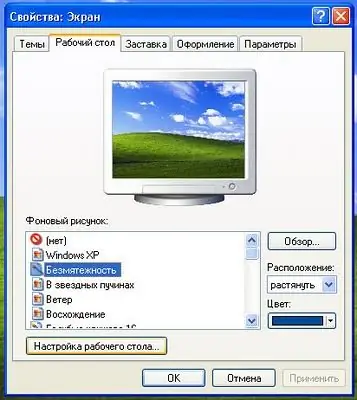The desktop is a virtual display space that graphically displays icons for programs, working folders, and document files that the user needs for quick access. Essentially, this is your personal workspace that can be customized to be functional, comfortable and pleasing to the eye.

Instructions
Step 1
Right-click on an empty space on the desktop - a context menu will open. Place the cursor on the "Properties" line and click on it with the left mouse button. The "Properties: Display" settings window appears.
Step 2
Start with the Themes tab. A desktop theme is a wallpaper (picture), a collection of sounds, icons, and other elements used to customize the look of your desktop with a single click. Hover the cursor over the theme you like, left-click on it, and after clicking on the "Apply" button, your chosen option will immediately appear on your desktop.
Step 3
The "Desktop" tab allows you to change the background image (picture, wallpaper) in a given theme. It can be selected from the proposed set, or by clicking on the "Browse" button, you can access your own files. Select the picture you need. After the name of your object appears in the "File name" field, click "Open". In the "Location" option, specify the location of the picture by choosing one of the options offered to you: center, pave, stretch. If you like a "clean" desktop, then in the list of themes select "No" and in the "Color" option select a color for the background of the desktop.
Step 4
Without leaving the "Desktop" tab, click "Desktop Settings". This will open the "Desktop Elements" window. Select the General tab. Here you can turn the system icons on and off by checking the corresponding checkboxes. If you wish, you can change the graphic representation of the icons using the Change Icon button. At the bottom of the window, you can configure automatic control of cleaning the desktop from unused items. If you do not need this, then just leave the checkbox unchecked.
Step 5
If instead of a background image you want to see a page from the Internet on your desktop, then go to the "Web" tab. To prohibit changing and moving desktop elements, select the checkbox of the "Freeze desktop elements" option. Save the changes using the Ok button. The Desktop Elements window closes. Finish work in this tab by clicking the "Apply" button.
Step 6
With the help of the "Screensaver" tab you can customize the so-called "Screensaver". This feature was needed when monitors consisted of a cathode ray tube to prevent fading. Modern monitors do not need such protection, and this function is useful to protect confidential information from curious or intruders. To do this, select a suitable screensaver from the proposed set, program the time interval after which it will turn on automatically if you do not manipulate the mouse and keyboard, and set password protection.
Step 7
To change the monitor's power settings, click the Power button. The "Properties: Power Options" window opens, with which you can manage sleep mode and the uninterruptible power supply. Save the settings and close the window with the OK button. Before leaving the tab, click the "Apply" button.
Step 8
The next tab "Appearance" offers a choice of styles for opening windows and buttons, colors and font size. Using the Effects and Advanced buttons, you can assign additional parameters to the selected design style in the form of drop shadows for menus, anti-aliasing of screen fonts, large icons, and more.
Step 9
On the last tab, Options, use the slider to set your screen resolution options. For a 17 "monitor, the optimal resolution is 1024x768, for a 19" monitor - 1280x1024 or 1400x1050. In the lower right corner of the window, click on the "Advanced" button and select the "Monitor" tab. Set the maximum refresh rate of the screen. Save with the Ok button. Click on the "Apply" button.
So, you've finished setting up the display properties. Now close the "Display Properties" window by clicking on the cross in the upper right corner of the window.
Step 10
Return to the context menu again by right-clicking on an empty space on the desktop.
The Arrange Icons option will help you arrange the icons on the desktop in the way that suits you best for your work.
The "Paste" option will give you the option to place the previously copied file on your desktop.
With the New option you can create a new document file or a new working folder.






